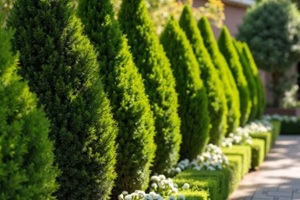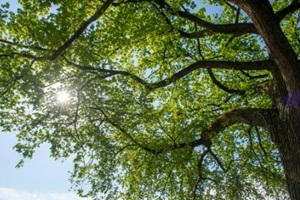
Proper tree trimming blends art and science, shaping a tree’s appearance while protecting its health for years to come. Every cut affects how the tree grows, responds to stress, and interacts with its environment. By applying proven techniques at the right time, professional arborists help trees remain strong, safe, and visually appealing while supporting the overall ecosystem.
Below are some ways arborists use techniques backed by science to keep your trees healthy, strong, and beautiful.
How Tree Trimming Supports Tree Health
Pruning helps trees maintain structure and resist disease. Cutting a branch just beyond the branch collar, without damaging that area, promotes natural wound sealing and prevents pathogens from entering the trunk’s xylem. That wound-sealing process, called compartmentalization, is the tree’s first defense against decay.
Removing dead, diseased, or crossing branches reduces self-wounding and limits the spread of infection. Especially for trees with more than one stem or trunk (known as “co-dominant leaders”), selective pruning encourages a single dominant trunk, saving the tree from future structural failure.
Trimming can also reduce wind resistance, which helps trees withstand storms by removing weak or poorly attached limbs before they cause damage.
Timing Matters for Trimming Success
Optimal trimming aligns with a tree’s natural growth cycle. Dormant, deciduous species should be trimmed in late winter just before spring growth, when wounds seal faster and pathogen risk is lower. For evergreen species, early spring trimming helps avoid disruption during active growth cycles.
Pruning at an inappropriate time may affect the tree’s health, increase susceptibility to pests, or slow the recovery process. For example, trimming maples during peak sap flow in early spring can cause excessive bleeding, while summer pruning can slow growth and reduce energy reserves needed for winter survival.
Structural Benefits and Growth Control

Trimming is an appearance upgrade that is also grounded in plant biology. USDA guidelines recommend crown thinning, retaining no more than 25% of the live crown in one session, to improve light and air flow, which supports healthy growth and reduces stress.
In forest management, thinning (including selective pruning and spacing) has been shown to increase diameter growth, crown size, and resistance against wind, fire, and pests, enhancing overall tree resilience.
On residential properties, structural pruning improves a tree’s ability to bear weight without splitting and prevents branches from interfering with roofs, wires, or neighboring plants.
Environmental and Public Health Advantages
Well-trimmed trees contribute more effectively to the environment. Urban forests help lower temperatures through shade and evapotranspiration, improving comfort, reducing energy use, and preventing heat-related illnesses.
Trees also absorb air pollutants and intercept stormwater, reducing flooding and supporting water quality. They store carbon and lower carbon emissions associated with cooling needs. Indirectly, a lush environment encourages more outdoor activity which can provide physical and mental health benefits.
Why Professional Trimming Counts
Tree trimming may look simple, but incorrect cuts can harm or even kill a tree. Poor pruning can start a decline spiral or turn a healthy tree into a landscape liability. Removing too much live growth, more than two-thirds of a tree’s height or more than half its branches, puts it under extreme stress.
Professional arborists know how to assess species-specific growth patterns, account for environmental stressors, and create a trimming plan that protects tree health. For instance, pruning a mature oak in late summer could encourage fungal infection, while trimming young ornamental trees too aggressively could stunt their form permanently.
Certified arborists apply precision cuts, preserve branch collars, and improve structure without over-pruning. Their process is grounded in science, with a focus on long-term stability and aesthetics.
The Connection Between Trimming and Safety
A poorly maintained tree can become a hazard. Weak or overextended limbs are more likely to snap under heavy snow or strong wind, which can damage property or injure people. Strategic trimming removes these hazards before they cause harm.
This maintenance also provides clearance for driveways, sidewalks, and roadways, which are essential for pedestrian and vehicle safety. In some areas, local regulations require homeowners to keep public walkways clear of low branches, making routine trimming a practical and legal necessity.
Preserve Your Landscape with RTEC Treecare

Healthy, well-trimmed trees can enhance property value, and neglected or poorly trimmed ones can become hazards. RTEC Treecare serves homeowners in McLean and throughout Northern Virginia, providing science-based pruning techniques rooted in environmental stewardship and ongoing education, to help boost your property value and your home’s beauty and longevity.
With certified ISA arborists and TCIA accreditation, RTEC offers tree trimming that supports long-term vitality, sustainability, and visual appeal. Each job reflects a preservation-based approach that respects your landscape.
Contact RTEC Treecare online or call (571) 506-6140 to arrange a consultation. Let the professionals provide thoughtful trimming that protects your property, promotes health, and enhances your landscape for years to come.


